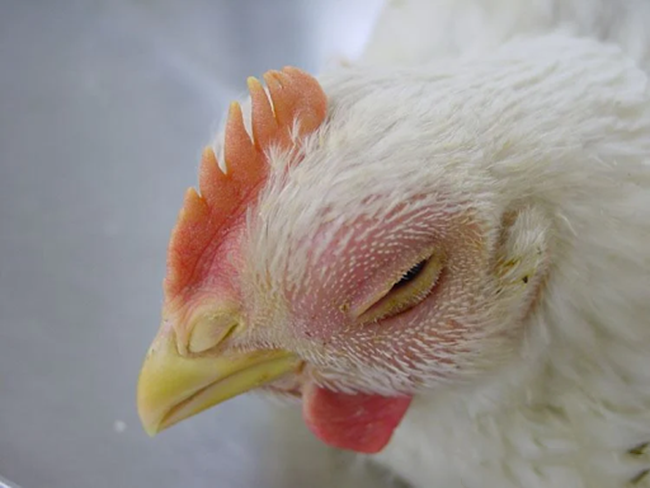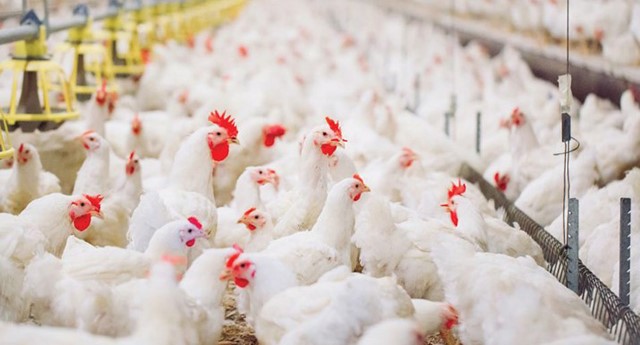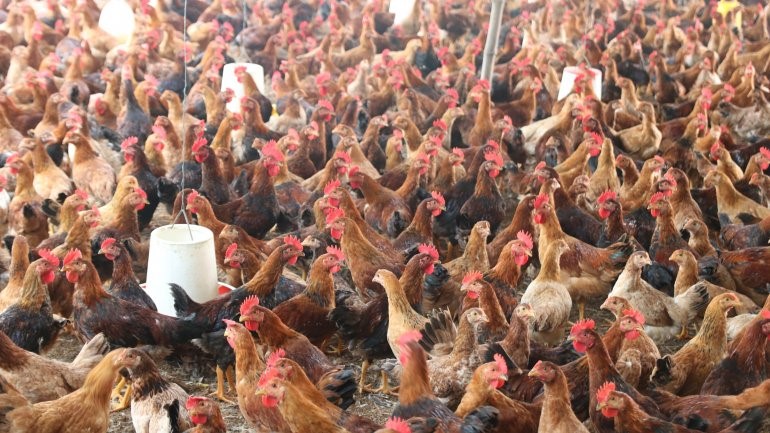APV disease in chicken is popular and often cause great losses to farmers if the infection rate is high .
Recently, APV disease has become relatively common, and when chickens have this disease, it is often confused with swollen head disease caused by Coryza, and treated according to the method of treating Coryza disease but it does not cure. So what are the symptoms and causes of APV?
I. CAUSES
APV disease is caused by Avian pneumovirus, an RNA virus that causes respiratory disease in chickens of all ages.
The disease is transmitted through the respiratory tract and often occurs when stocking density is high and barn management is poor, toxic gas content in the barn is high such as NH3, CO2, H2S, etc.
The disease has a high infection rate, up to 100%. The mortality rate depends on the underlying pathogen. When infected with APV, chickens are very susceptible to common diseases such as E.Coli, Coryza, typhoid, asthma, CRD, etc. because these are all bacteria that are readily available in the chicken barn and body. And when chickens get graft disease, the death rate will increase. Therefore, it is necessary to detect and treat promptly based on the symptoms
Image of a flock of chickens
II. SYMPTOM
– Chickens grow slowly, eat less, become moody, and have matted feathers
– Foamy, watery eyes. This is one of the characteristic manifestations of the disease
– Chickens have difficulty breathing, breathe rapidly, and have tracheal rales
– Chickens have rhinitis and runny nose
– Swelling of the head and face, head tremors, scalp edema (This symptom can easily be confused with Coryza disease)
– Chickens can become paralyzed and have their necks twisted
– In severe cases, APV is combined with E.Coli, causing Swollen head syndrome. This syndrome occurs in chickens over 1 month old with typical neurological and respiratory symptoms such as: Chickens have difficulty walking, wringing their necks, shaking their heads, swelling of the head, face and eyes.
– For laying hens: Ovaries are broken, atrophied, deformed, eggshells are thin and pale, the rate decreases by 5-30%.
– For chicken breeds: hatching rate decreases by 5-10%
III. LESION
– Eyelid inflammation, blindness, inflammation and yellow Fibrin layer under the scalp and cheek skin
– Trachea has mucus but no bleeding. Chickens with severe APV will have bleeding at the end of the trachea
– Laying hens: ovaries are easily damaged, young eggs are easily broken, causing peritonitis
Image of APV disease in chicken
IV. PREVENTION
– Keep the cage well-ventilated, with reasonable density, and periodically clean and disinfect once a week with Iodin @ or Dexon Super according to the manufacturer’s instructions.
– Use biological products or deodorizing minerals, such as Bio Farm or Stop Odor, to minimize toxic gases in the barn, helping to minimize respiratory diseases as well as APV disease in chickens.
– Prevent disease with full vaccination
– Use Glucan C or Promulti ws according to the manufacturer’s recommended dose to increase resistance and limit stress for chickens.
V. TREATMENT
– Because APV is a disease caused by a virus, there is no specific medicine to treat this disease. However, people need to treat the symptoms and use antibiotics to prevent and treat secondary diseases, and at the same time clean the barn and animals area with antiseptic products in disease prevention, to destroy pathogens in the environment
Image of a flock of chickens
– To treat disease symptoms, use the following medications:
Cough suppressant, expectorant, fever reducer: using Phenycin oral helps reduce cough, expectorate, anti-inflammatory and fever-reducing.
Or use Brom 20 ws to loosen phlegm and reduce cough. In case the chicken has fever, use Paramol 200 ws to reduce the fever and help the chicken recover quickly
Using antibiotics for secondary prevention:
Regimen 1: Mild cases
Powdered antibiotics can be used to mix food and drink for chickens as follows: Use antibiotics Flo + doxy Or Doxy + tylo: mix for 3-5 days. It is recommended that people use products such as Flodox 150 ws or Tylodox ws or Doxy 50 + Macrolan ws.
Regimen 2: In case the chicken is seriously ill
Inject a pair of Ceftifur power + Genta 5% + Lincospectin
Or you can inject Ceftifur power + Genta 5% + Linspectin + Energi 300. Inject 1ml of mixed solution per 3-5 kg body weight
Inject continuously for 2-3 days, then use regimen 1 for another 2-3 consecutive days
Knowing information about the causes and symptoms of APV disease in chickens helps farmers care for and prevent the disease in chickens more effectively.



